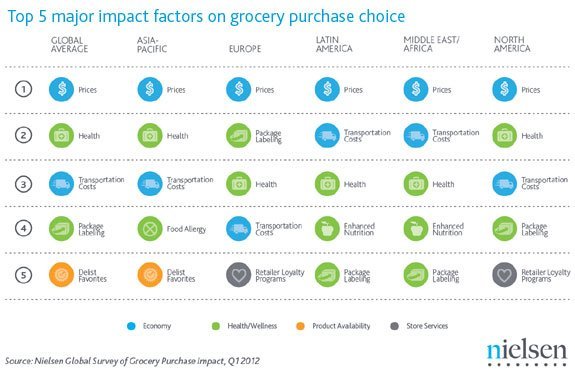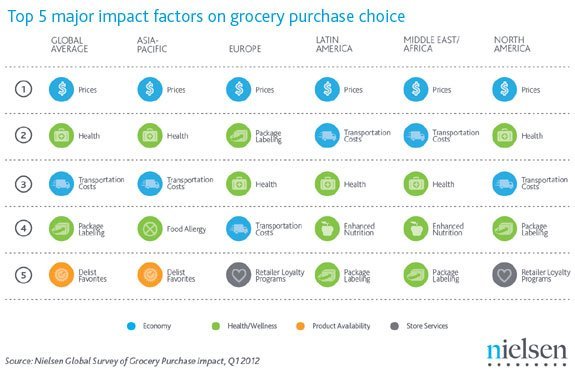
Research: Nielsen Global Study Shows Price, Nutrition Biggest Grocery Buying Factors
August 21, 2012 by Dave Haynes
The research firm Nielsen has some really interesting survey results out today about consumer decision making in grocery – with findings that may seem obvious in some respects but have some deeper implications.
To the surprise of probably no one, price is the biggest factor in grocery purchases around the world.
But price, reports Nielsen, is not the only consideration that weighs heavily on the minds of consumers when shopping for groceries. Health factors, product availability and in-store services are also important considerations.
New findings from a Nielsen online survey of respondents from 56 countries around the world provide insights into how 16 various factors have impacted grocery purchases in the last year. Manufacturers and retailers armed with this knowledge can fine-tune strategies to better align with what matters most to consumers—and what does not.
The rising price of food is the number one consideration among 16 factors measured by Nielsen that influence consumer’s choice of grocery purchases. The consistency of findings across the regions underscores the ongoing struggle consumers worldwide are grappling with in this volatile economic environment. The increasing cost of food is affecting 88 percent of respondents in Asia-Pacific, 86 percent in Latin America, 83 percent in North America, 82 percent in the Middle East/Africa region and 81 percent in Europe, with more than half of respondents in these regions indicating that rising food prices is having a major impact on choice of grocery purchases.
Soaring fuel prices, which lead to increased transportation costs, are also affecting consumer choice. More than one-third (35%) of global respondents consider the cost of traveling to buy groceries a major obstacle, ranking it among the top four key implications that affect grocery shopping choice across all regions. Forty-two percent regard transportation costs as a minor issue.
While many transportation-based factors, such as store proximity, cost of fuel and economic conditions can affect grocery shopping habits, retailers can alleviate some of the burden by integrating fuel benefits into their own loyalty scheme. Fuel points programs on-site or in close proximity to stores are proving to be a winning competitive strategy. Providing meal deals and recipe ideas for more at-home eating options and promoting convenient store locations are other ideas being explored. Retailers would also be wise to build in contingency plans that account for swings in gas prices during peak months when prices typically rise.
Other notable findings include:
- The influence of health factors on shopping choice is most significant in Asia-Pacific
- De-listing a favorite product is a major concern for 3-in-10 global respondents
- Retailer loyalty programs significantly impact shopping choice for 1-in-4 consumers worldwide
In addition to economic realities, health and wellness concerns are a driving force when it comes to deciding the grocery items purchased. Nielsen reviewed the impact of health factors (heart, cholesterol, obesity, etc.), food labeling information on packages, food allergy factors (gluten-free, nuts, etc.), the availability of products with enhanced nutritional benefits (vitamin-enriched juices, milks, etc.) and the availability of organic product options.
Among the health and wellness factors measured, those that relate to physical condition have the most significant impact on grocery purchase choice among global respondents (38%). Food labeling information on packaging is a key concern for 31 percent of total online shoppers, the availability of products with enhanced nutritional benefits is a major issue for 25 percent of global consumers and the availability of organic foods is a chief concern among 24 percent of respondents worldwide.
The need for better education on nutritional labeling is apparent. Findings from Nielsen’s January 2012 Global Food Labeling Report reveal that 59 percent of global respondents say they have difficulty grasping nutritional facts on product packaging, with 52 percent saying they understand the labels “in part” and seven percent not at all. Respondents are also largely skeptical about the accuracy and believability of the health claims.
Providing simple and easy-to-read labeling on packages coupled with an education program on how to interpret the facts can help reduce the skepticism that is apparent around all parts of the globe. As for allergy-conscious shoppers, retailers should consider dedicating a special section of the store (or store-in-store) to offer a wide range of gluten-free and other special dietary-needs products together with food recipes and meal planning ideas to meet shoppers’ diet needs.
Digital and interactive digital can very effectively deal with a lot of those issues – taking squint-worthy nutritional labeling in 5 point type on the packaging and getting it in 84 points or bigger on a digital screens, and allowing consumers to drill down or navigate to find out what they need.
It’s also interesting to read the survey rankings that show how little people care right now about the sizzle, like online shopping for groceries and handheld scanners. That’s all very nice, they seem to be saying, but they care a lot more about affordability and the quality of what’s being bought, cooked and brought to the dinner table.




Leave a comment